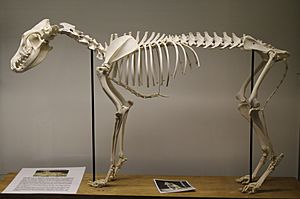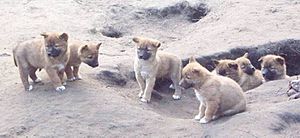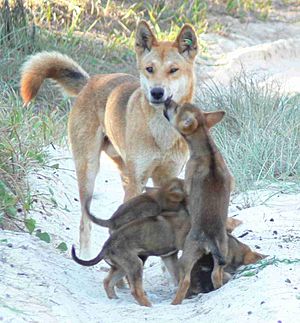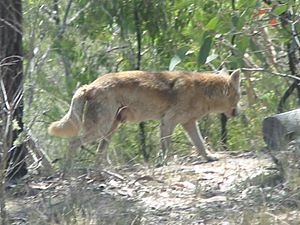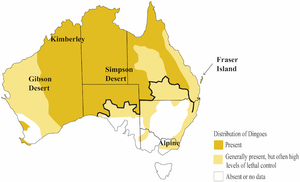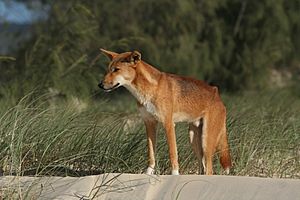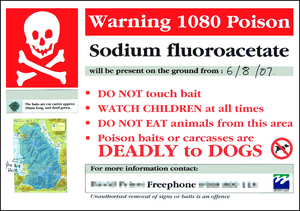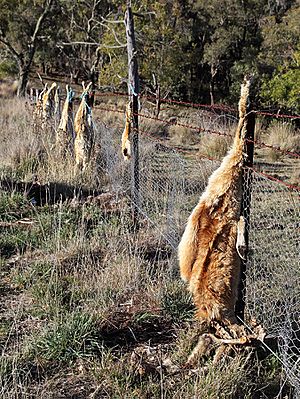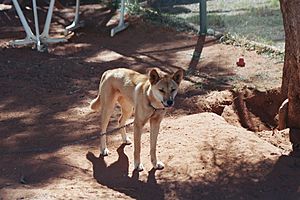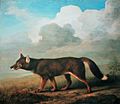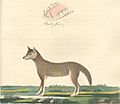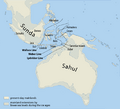Dingo facts for kids
Quick facts for kids Dingo |
|
|---|---|
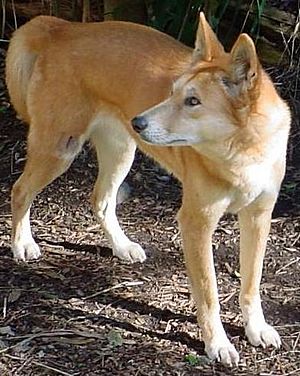 |
|
| Conservation status | |
| Scientific classification | |
| Kingdom: | |
| Phylum: | |
| Class: | |
| Order: | |
| Family: | |
| Genus: | |
| Species: | |
| Subspecies: |
C. l. dingo
|
| Trinomial name | |
| Canis lupus dingo (Meyer, 1793)
|
|
 |
|
| Dingo range | |
The Dingo (plural: dingoes or dingos) is a mammal found in Australia and South-East Asia. Dingos are similar to domestic dogs. Dingos were brought to Australia from South-East Asia about 4000 years ago. They are not found in Tasmania as the sea levels cut the island off from mainland Australia about 10,000 years ago. Most dingos in the wild are no longer purebreed dingos. Their scientific name, Canis lupus (wolf) dingo, changed recently from Canis familiaris (dog) dingo. This was to show it is related to the white footed wolf which lives in Asia.
Contents
Description
Dingos are usually between 117cm to 124cm in length. Their tail is about 30cm in length. They usually weigh between 10kg and 20kg. The colour of their fur is usually yellow-ginger, but can sometimes include tan, black, white or sandy colours. They live for about 14 years.
Dingos live in packs of between 3 and 12, but they can be seen alone as well. The leaders are the alpha male and the alpha female and are usually the only pair to breed. Young dingos are called "cubs". The breeding season is in March and April. After a gestation of 63 days, the adult females usually give birth to 4-5 cubs in a litter. Mothers will regurgitate food for the cubs to eat. They become independent of their mother after four to eight months of age.
Dingos do not bark like other dogs, but they do howl.
Description
In 2014, a study established a reference description of the dingo based on pre-20th century specimens that are unlikely to have been influenced by hybridisation. The dingo differs from the domestic dog by relatively larger palatal width, relatively longer rostrum, relatively shorter skull height and relatively wider top ridge of skull. A sample of 19th century dingo skins the study examined suggests that there was considerable variability in the colour of dingoes and included various combinations of yellow, white, ginger and darker variations from tan to black. Although it remained difficult to provide consistent and clear diagnostic features, the study placed morphological limits on what can be considered a dingo.
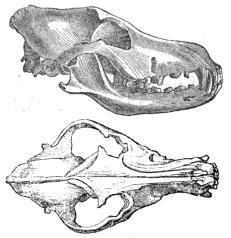
A dingo has a relatively broad head, a pointed muzzle and erect ears. Eye colour varies from yellow over orange to brown. Compared to other similarly sized familiaris dogs, dingoes have longer muzzles, larger carnassials (large teeth found in many carnivorous mammals), longer canine teeth, and flatter skulls with larger nuchal lines. The tail is flatish, tapering after mid-length and does not curve over the back but is carried low.
Size
The average Australian dingo is 52 to 60 cm (20 to 24 in) tall at the shoulders and measures 117 to 154 cm (46 to 61 in) from nose to tail tip. The average weight is 13 to 20 kg (29 to 44 lb); however, there are a few records of outsized dingoes weighing up to 27 to 35 kg (60 to 77 lb). Males are typically larger and heavier than females of the same age. Dingoes from northern and northwestern Australia are larger than central and southern populations. The legs are about half the length of the body and the head put together. The hind feet make up a third of the hind legs and have no dewclaws. Dingoes can have sabre-form tails (typically carried erect with a curve towards the back) or tails carried directly on the back.
Fur
Fur of an adult dingo is short and soft, bushy on the tail, and varies in thickness and length depending on the climate. The fur colour is mostly sandy to reddish brown, but can include tan patterns and sometimes be black, light brown, or white. Completely black dingoes might have been more prevalent in Australia in the past, but have only been rarely sighted in recent times.
Most dingoes are at least bi-coloured, with small, white markings on the chest, muzzle, tag, legs and paws being the most common feature, similar to the urajiro pattern in dogs. "Pure" dingoes are also found in white or cream (not albinism). They are also found in black and tan colourations. In the case of reddish individuals, there can be small, distinctive, dark stripes on the shoulders.
Life expectancy
Dingoes in the wild live between 3-5 years with few living past 7-8 years. Some have been recorded living up to 10 years. In captivity dingoes live between 12-14 years of age.
Communication
Like all domestic dogs, dingoes tend towards phonetic communication. However, in contrast to domestic dogs, dingoes howl and whimper more, and bark less. Eight sound classes with 19 sound types have been identified.
Barking
Compared to most domestic dogs, the bark of a dingo is short and monosyllabic, and is rarely used. Barking was observed to make up only 5% of vocalisations. Dog barking has always been distinct from wolf barking. Australian dingoes bark mainly in swooshing noises or in a mixture of atonal and tonal sounds. In addition, barking is almost exclusively used for giving warnings. Warn-barking in a homotypical sequence and a kind of "warn-howling" in a heterotypical sequence have also been observed. The bark-howling starts with several barks and then fades into a rising and ebbing howl and is probably (similar to coughing) used to warn the puppies and members of the pack. Additionally, dingoes emit a sort of "wailing" sound, which they mostly use when approaching a wateringhole, probably to warn already present dingoes.
According to the present state of knowledge, it is not possible to get Australian dingoes to bark more frequently by putting them in contact with other domestic dogs. However, German zoologist Alfred Brehm reported a dingo that learned the more "typical" form of barking and how to use it, while its brother did not. Whether dingoes bark or bark-howl less frequently in general is not certain.
Howling
Dingoes have three basic forms of howling (moans, bark-howls and snuffs) with at least 10 variations. Usually, three kinds of howls are distinguished: long and persistent, rising and ebbing, and short and abrupt.
Observations have shown that each kind of howling has several variations, though their purpose is unknown. The frequency of howling varies with the season and time of day, and is also influenced by breeding, migration, lactation, social stability and dispersal behaviour. Howling can be more frequent in times of food shortage, because the dogs become more widely distributed within their home range.
Additionally, howling seems to have a group function, and is sometimes an expression of joy (for example, greeting-howls). Overall howling was observed less frequently in dingoes than among grey wolves. It may happen that one dog will begin to howl, and several or all other dogs will howl back and bark from time to time. In the wilderness, dingoes howl over long distances to attract other members of the pack, to find other dogs, or to keep intruders at bay. Dingoes howl in chorus with significant pitches, and with increasing number of pack-members, the variability of pitches also increases. Therefore, it is suspected that dingoes can measure the size of a pack without visual contact. Moreover, it has been proposed that their highly variable chorus howls may generate a confounding effect in the receivers by making pack size appear larger.
Other forms of communication
Growling, making up approximately 65% of the vocalisations, is used in an agonistic context for dominance, and as a defensive sound. Similar to many domestic dogs, a reactive usage of defensive growling is only rarely observed. Growling very often occurs in combination with other sounds, and has been observed almost exclusively in swooshing noises (similar to barking).
During observations in Germany, dingoes were heard to produce a sound that observers have called Schrappen. It was only observed in an agonistic context, mostly as a defence against obtrusive pups or for defending resources. It was described as a bite intention, during which the receiver is never touched or hurt. Only a clashing of the teeth could be heard.
Aside from vocal communication, dingoes communicate, like all domestic dogs, via scent marking specific objects (for example, Spinifex) or places (such as waters, trails and hunting grounds) using chemical signals from their urine, feces and scent glands. Males scent-mark more frequently than females, especially during the mating season. They also scent-rub, whereby a dog rolls its neck, shoulders, or back on something that is usually associated with food or the scent markings of other dogs.
Unlike wolves, dingoes can react to social cues and gestures from humans.
Behaviour
Dingoes tend to be nocturnal in warmer regions, but less so in cooler areas. Their main period of activity is around dusk and dawn. The periods of activity are short (often less than one hour) with short times of resting. Dingoes have two kinds of movement: a searching movement (apparently associated with hunting) and an exploratory movement (probably for contact and communication with other dogs).
In general, dingoes are shy towards humans. However, there are reports of dingoes that were agitated by the presence of humans, such as around camps in national parks, near streets or suburbs.
Some Australian researchers use the term "wild dog" when referring to both dingoes and dingo-dog hybrids. Others regard the dingo as a domesticated dog that has gone feral and is the only known dog population to have maintained a long-term independence from humans. According to studies in Queensland, the wild dogs (dingo hybrids) there, move freely at night through urban areas and cross streets and seem to get along quite well.
Dietary habits
About 170 species (from insects to buffalo) have been identified as part of the dingo's diet. In general, livestock seems to make up only a small proportion of their diet. In continent-wide examinations, 80% of the diet of wild dogs consisted of 10 species: red kangaroo, swamp wallaby, cattle, dusky rat, magpie goose, common brushtail possum, long-haired rat, agile wallaby, European rabbit and the common wombat. This narrow range of major prey indicates these wild dogs are rather specialised, but in the tropical rainforests of northeastern Australia, dingoes are supposed to be opportunistic hunters of a wide range of mammals. In certain areas, they tend to specialise on the most common prey, with a preference for medium- to large-sized mammals. Their consumption of domestic cats has also been proven. Non-mammalian prey is irregularly eaten and makes up only 10% of the dingo's diet. Big reptiles are only rarely captured, at least in eastern Australia, although they are widespread. It is possible that especially large monitor lizards are too defensive and well-armed, or they are simply able to flee fast enough into dens or climb trees.
Dietary composition varies from region to region. In the gulf region of Queensland, feral pigs and agile wallabies are the dingo's main prey. In the rainforests of the north, the main prey consists of magpie geese, rodents and agile wallabies. In the southern regions of the Northern Territory, the dogs mainly eat European rabbits, rodents, lizards and red kangaroo; in arid Central Australia, rabbits, rodents, lizards, red kangaroo and cattle carcasses; and in the dry northwest, eastern wallaroos and red kangaroo. In the deserts of the southwest, they primarily eat rabbits, and in the eastern and southeastern highlands, they eat wallabies, possums and wombats.
To what extent the availability of rabbits influences the composition of the diet cannot be clarified. However, because rabbit haemorrhagic disease killed a large part of the Australian rabbit population at the end of the 20th century, it is suspected that the primary prey of the dogs has changed in the affected areas. Also, on Fraser Island, fish have been proven to be a part of the dingo diet. The main prey species, though, are bandicoots and several rodents. Dingoes also eat a lot of echidnas, crabs, small skinks, fruits and other plants, as well as insects (mostly beetles). During these observations, only 10% of the examined faeces-samples contained human garbage (in earlier studies 50% were reported).
When scavenging for food, wild dogs (presumably, all dogs free to roam, not just dingoes) primarily eat cattle and kangaroo carcasses. Dingoes in coastal regions regularly patrol the coast for dead fish, seals, penguins and other washed-up birds.
Dingoes in general drink one litre of water a day in the summer and about half a litre a day in winter. During the winter in arid regions, dingoes could potentially live from the liquid in the bodies of their prey, as long as the number of prey is sufficient. Similarly, weaned pups in Central Australia are able to draw their necessary requirements of liquid from their food. There, regurgitation of water by the females for the pups was observed. During lactation, females have no higher need of water than usual, since they consume the urine and feces of the pups and therefore recycle the water and keep the den clean.
17 tracked dingoes have survived 22 days without water in the winter.
Hunting behaviour
Dingoes often kill by biting the throat, and they adjust their hunting strategies to suit circumstances. For larger prey, due to strength and potential danger, two or more individuals are needed to bring down the prey. Such group formations are unnecessary when hunting rabbits or other small prey.
Kangaroo hunts are probably more successful in open areas than in places with high densities of vegetation, and juvenile kangaroos are killed more often than adults. Dingoes typically hunt large kangaroos by having lead dingoes chase the quarry toward their waiting packmates, which are skilled at cutting corners in chases. In one area of Central Australia, dingoes hunt kangaroos by chasing them toward a wire fence that hindered their escape.
Birds can be captured when they do not fly or fail to take off fast enough. Dingoes also steal the prey of eagles and the coordinated attack of three dingoes for killing a large monitor lizard has been observed.
Reports state that some dingoes live almost entirely on human food through stealing, scavenging, or begging. In fact, dingoes are well known for such behaviour in some parts of Australia. It is suspected that this might cause the loss of hunting strategies or a change in the social structures.
During studies at the Fortescue River in the mid-1970s, observation showed that most of the studied dingoes learned to hunt and kill sheep very quickly, even without prior contact with sheep. Although the dingoes killed many sheep at that time, they still killed and ate kangaroos.
During the early 1990s, wild dogs were observed to have an extraordinarily high success rate when killing sheep, and did not have to hunt in a coordinated manner to achieve success. Often, a dog may chase and outrun a single sheep, only to turn away suddenly and chase another. Therefore, only a small proportion of the injured or killed sheep and goats are eaten, which seems to be the rule and not the exception. The dog probably falls into some kind of "killing spree," due to the rather panicked and uncontrolled flight behaviour of the sheep, which run in front of the dingoes time and again and, therefore, cause one attack after another. Dingoes often attack sheep from behind during the sheep's flight, which causes injuries to the sheep's hind legs. Rams are normally attacked from the side – probably in order to avoid the horns. Inexperienced dingoes, or those that kill "for fun," sometimes cause significant damage to the sheep's hind legs, which often causes death.
Nearly all dingo attacks on cattle and water buffalo are directed against calves. Hunting success depends on the health and condition of the adult bovines and on their ability to defend their calves. The defence behaviour of the mother can be sufficient to fend off an attack. Therefore, the basic dingo tactics of attack are distracting the mother, rousing the herd/group and waiting (sometimes for hours), and testing of the herd to find the weakest members.
While locating a cattle herd, dingoes have been observed to make several feint attacks, during which they concentrate on the calves at first then, later on, attack the mothers to distract them. Thereupon, the dingoes retreat and wait at a distance from the herd until the rest of the cows have gathered their calves and move on.
During another observed attack, "subgroups" of a dingo pack took turns in attacking and resting, until the mother was too tired to effectively defend her calf. Dingoes have been observed hunting a water buffalo with an estimated weight of 200 kg, and taking turns biting the buffalo's legs during the chase.
Social behaviour
The dingo's social behaviour is about as flexible as that of a coyote or gray wolf, which is perhaps one of the reasons it was initially believed that the dingo was descended from the Indian wolf. While young males are often solitary and nomadic in nature, breeding adults will often form a settled pack. However, in areas of the dingo's habitat with a widely spaced population, breeding pairs remain together, apart from others.
Where conditions are favourable among dingo packs, the pack is stable with a distinct territory and little overlap between neighbors. The size of packs often appears to correspond to the size of prey that appears in the pack's territory. Desert areas have smaller groups of dingoes with a more loose territorial behaviour and sharing of the water sites. It has been noted that the average monthly pack size was between three and twelve members.
Similar to other canids, a dingo pack largely consists of a mated pair, their current year's offspring, and occasionally a previous year's offspring. There are dominance hierarchies both between and within males and females, with males usually being more dominant than females. However, a few exceptions have been noted in captive packs. During travel, while eating prey, or when approaching a water source for the first time, the breeding male will be seen as the leader, or alpha. Subordinate dingoes will approach a more dominant dog in a slightly crouched posture, ears flat and tail down, to ensure peace in the pack. Establishment of artificial packs in captive dingoes have failed.
Reproduction
Dingoes breed once annually.
The mating season usually occurs in Australia between March and May (according to other sources between April and June). During this time, dingoes may actively defend their territories using vocalisations, dominance behaviour, growling and barking.
Most females in the wild start breeding at the age of two years. Males become sexually mature between the ages of one and three years. The precise start of breeding varies depending on age, social status, geographic range and seasonal conditions.
In general, the only dingoes in a pack that successfully breed are the alpha pair, and the other pack members help with raising the pups. Subordinates are actively prevented from breeding by the alpha pair. Low-ranking or solitary dingoes can successfully breed if the pack structure breaks up.
The size of the litter can range from one to 10 (usually five) pups, with the number of males born tending to be higher than that of females. Pups of subordinate females usually get killed by the alpha female, which causes the population increase to be low even in good times. This behaviour possibly developed as an adaptation to the fluctuating environmental conditions in Australia. Pups are usually born between May and August (the winter period), but in tropical regions, breeding can occur at any time of the year.
At the age of three weeks, the pups leave the den for the first time, and leave it completely at eight weeks. In Australia, dens are mostly underground. There are reports of dens in abandoned rabbit burrows, rock formations, under boulders in dry creeks, under large spinifex, in hollow logs, in augmented burrows of monitor lizards and wombat burrows. The pups usually stray around the den within a radius of 3 km, and are accompanied by older dogs during longer travels. The transition to consuming solid food is normally accompanied by all members of the pack during the age of 9 to 12 weeks. Apart from their own experiences, pups also learn through observation. Young dingoes usually become independent at the age of three to six months or they disperse at the age of 10 months when the next mating season starts.
Interbreeding with domestic dogs
European domestic dogs first arrived in Australia during the European colonisation. These dogs reverted to the wild (both unintentionally and intentionally), produced feral populations and interbred with the existing dingoes. Hybrids of dingoes and domestic dogs exist today in all wild dog populations of Australia, with their numbers having increased to such a degree that any completely "pure" populations may no longer exist. The degree of interbreeding is locally so high, for instance in urban and rural areas, that there are big populations consisting purely of hybrids. Estimates from the 1990s assumed a proportion of dingo-hybrids of about 78% in the wild. It is not clear how large the current population of hybrids is today.
Dingo-like domestic dogs and dingo-hybrids can be generally distinguished from "pure" dingoes by their fur colour, since there is a wider range of colours and patterns among them than among dingoes. In addition, the more dog-typical kind of barking exists among the hybrids, and differences in the breeding cycle, certain skull characteristics, and genetic analyses can be used for differentiation. Despite all the characteristics that can be used for distinguishing between dingoes and other domestic dogs, there are two problems that should not be underestimated. First, there is no real clarity regarding at what point a dog is regarded as a "pure" dingo, and, secondly, no distinguishing feature is completely reliable—it is not known which characteristics permanently remain under the conditions of natural selection.
In science, there are two main opinions regarding this process of interbreeding. The first, and likely most common, position states that the "pure" dingo should be preserved via strong controls of the wild dog populations, and only "pure" or "nearly-pure" dingoes should be protected. The second position is relatively new and is of the opinion that people must accept that the dingo has changed and that it is impossible to bring the "pure" dingo back. Conservation of these dogs should therefore be based on where and how they live, as well as their cultural and ecological role, instead of concentrating on precise definitions or concerns about "genetic purity". Both positions are controversially discussed.
Due to this interbreeding, there is a wider range of fur colours, skull shapes and body size in the modern-day wild dog population than in the time before the arrival of the Europeans. Over the course of the last 40 years, there has been an increase of about 20% in the average wild dog body size. It is currently unknown whether, in the case of the disappearance of "pure" dingoes, remaining hybrids would alter the predation pressure on other animals. It is also unclear what kind of role these hybrids would play in the Australian ecosystems. However, it is unlikely that the dynamics of the various ecosystems will be excessively disturbed by this process.
Migration
Dingoes usually remain in one area and do not undergo seasonal migrations. However, during times of famine, even in normally "safe" areas, dingoes travel into pastoral areas, where intensive, human-induced control measures are undertaken. It was noted in Western Australia in the 1970s that young dogs can travel for long distances when necessary. About 10% of the dogs captured—all younger than 12 months—were later recaptured far away from their first location. Among these, 10% of the travelled distance for males was 21.7 km and for females 11 km. Therefore, travelling dingoes had lower chances of survival in foreign territories, and it was apparently unlikely that they would survive long migrations through occupied territories. The rarity of long migration routes seemed to confirm this. During investigations in the Nullarbor Plain, even longer migration routes were recorded. The longest recorded migration route of a radio-collared dingo was about 250 km.
Attacks on humans
Although dingoes are large enough to be dangerous, they generally avoid conflict with humans. Apart from the well-known case in which an infant was taken from a campsite (see below), there have been numerous confirmed dingo attacks, often involving people feeding wild dingoes, particularly on Fraser Island, a special center of dingo-related tourism (see main article). Most dingo attacks are minor in nature, but some can be major, and a few can be fatal. Many Australian national parks have signs advising visitors not to feed wildlife, partly because this practice is not healthy for the animals, and partly because it may encourage undesirable behaviour, such as snatching or biting by dingoes, kangaroos, goannas and some birds.
Habitat
Dingoes live in many diverse habitats, including the snow-covered mountain forests of eastern Australia, the deserts of Central Australia, and Northern Australia's tropical forest wetlands. The absence of dingoes in many parts of the Australian grasslands is probably due to human persecution. Based on skull characteristics, size, fur colour and breeding cycles, distinct regional populations could not be seen within Australia.
The wild dog population of Australia now includes dingoes and a wide panoply of feral domestic dogs (mostly mixed-breeds and dingo-hybrids) having an enormous variety of colours. Due to the increased availability of water, native and introduced prey, livestock and human-provided food, this population is on the increase. Reports from some parts of Australia indicate that wild dogs now hunt in packs there, where they had previously been solitary hunters. Dingo densities have been measured at up to 0.3 per square kilometre in both the Guy Fawkes River region of New South Wales and in South Australia at the height of a rabbit plague.
"Pure" dingoes are regarded as widespread in Northern, North West and Central Australia; rare in Southern and Northeast Australia; and possibly extinct in the Southeastern and Southwestern areas.
The establishment of agriculture caused a significant decrease in dingo numbers, and dingoes were practically expelled from the territories occupied by the sheep industry, primarily affecting large parts of southern Queensland, New South Wales, Victoria and South Australia. This situation was maintained by the construction of the Dingo Fence. Although dingoes were eradicated from most areas south of the Dingo Fence, they still exist in an area of about 58,000 km2 in the dry northern areas north of the Dingo Fence and, therefore, on about 60% of the entire area.
In Victoria, wild dog populations are currently concentrated on the densely forested areas of the Eastern Highlands, from the border to New South Wales, south to Healesville and Gembrook. They also exist in semi-arid areas in the northwest of the state. Wild dog populations in New South Wales primarily exist along the Great Dividing Range and the hinterlands on the coast, as well as in the Sturt National Park in the northwest of the state.
In the rest of the continent, dingoes are regarded as widespread, with the exception of the arid eastern half of Western Australia. In the bordering areas of South Australia and the Northern Territory, they are regarded as naturally scarce. Wild dogs are widespread in the Northern Territory, with the exception of the Tanami and Simpson Deserts, where they are rare due to the lack of watering holes. However, local concentrations exist there near artificial water sources. According to DNA examinations from 2004, the dingoes of Fraser Island are "pure". However, skull measurements from the mid-1990s had a different result. A 2013 study showed that dingoes living in the Tanami Desert are among the "purest" in Australia.
Impact
The dingo has had an ecological, cultural and economic impact in Australia and is thought by some authors to have caused the extinction of the thylacine on mainland Australia.
Extinctions
The dingo is suspected to have caused the extinction of the thylacine, the Tasmanian devil and the Tasmanian nativehen from mainland Australia, since a correlation in space and time is found between the arrival of the dingo and the extinctions of these species. Recent studies have questioned this theory, suggesting that climate change and increasing human populations may have been the cause. Dingoes do not seem to have had the same ecological impact that the red fox had in later times. This might be connected to the dingo's way of hunting and the size of their favoured prey, as well as to the low number of dingoes in the time before European colonisation.
The assumption that dingoes and thylacines were competitors for the same prey stems from their external similarities; the thylacine had a stronger and more efficient bite, but was probably dependent on relatively small prey, while the dingo's stronger skull and neck would have allowed it to bring down bigger prey. The dingo was probably a superior hunter, as it hunted cooperatively in packs and could better defend resources, while the thylacine was probably more solitary. Also, wild dingo populations might have had demographic support from conspecific living with humans.
The extinction of the thylacine on the continent around 2,000 years ago has also been linked to changes in climate and land use by the Aborigines. It is plausible to name the dingo as the cause of the extinction, but significant morphological differences between the two suggest that the ecological overlapping of both species might be exaggerated. The dingo has the dentition of a generalist, while the thylacine had the dentition of a specialist carnivore without any signs of consumption of carrion or bones. It is also argued that the thylacine was a flexible predator that should have withstood the competition by the dingo, but was instead wiped out due to human persecution.
This theory does not explain how the Tasmanian devil and the dingo coexisted on the same continent until about 430 years ago, when the dingo supposedly caused the Tasmanian devil's demise. The group dynamics of dingoes should have successfully kept devils away from carrion, and since dingoes are able to break bones, little would have been left for the devils to scavenge. Additionally, devils are successful hunters of small- to medium-sized prey, so there should have been an overlapping of the species in this area, too. Furthermore, the arguments that the dingo caused the extinction of the thylacine, the devil and the hen are in direct conflict with each other. If the dingo were really so similar to the thylacine and the Tasmanian devil in its ecological role and suppressed both, then coexisting with both for such an extended time is strange. Although this is a possible result of the dingo's introduction, critics regard the evidence for this as insubstantial.
Ecological impact
The dingo is regarded as part of the native Australian fauna by many environmentalists and biologists, as these dogs existed on the continent before the arrival of the Europeans and a mutual adaptation of the dingoes and their surrounding ecosystems had occurred.
Much of the present place of wild dogs in the Australian ecosystem, especially in the urban areas, remains unknown. Although the ecological role of dingoes in Northern and Central Australia is well understood, the same does not apply to the role of wild dogs in the east of the continent. In contrast to some claims, dingoes are assumed to have a positive impact on biodiversity in areas where feral foxes are present.
Dingoes are regarded as apex predators and possibly perform an ecological key function. It is likely (with increasing evidence from scientific research) that they control the diversity of the ecosystem by limiting the number of prey and keeping the competition in check. Wild dogs hunt feral livestock such as goats and pigs, as well as native prey and introduced animals. The low number of feral goats in Northern Australia is possibly caused by the presence of the dingoes, but whether they control the goats' numbers or not is still disputable. Studies from 1995 in the northern wet forests of Australia found the dingoes there did not reduce the number of feral pigs, but their predation only affects the pig population together with the presence of water buffaloes (which hinder the pigs' access to food).
Observations concerning the mutual impact of dingoes and red fox and cat populations suggest dingoes limit the access of foxes and cats to certain resources. As a result, it is assumed that a disappearance of the dingoes may cause an increase of red fox and feral cat numbers and, therefore, a higher pressure on native animals. These studies found the presence of dingoes is one of the factors that keep fox numbers in an area low, and therefore reduces pressure on native animals, which then do not disappear from the area. The countrywide numbers of red foxes are especially high where dingo numbers are low, but other factors might responsible for this, depending on the area. Evidence was found for a competition between wild dogs and red foxes in the Blue Mountains of New South Wales, since there were many overlaps in the spectrum of preferred prey, but there was only evidence for local competition, not on a grand scale.
It is also possible that dingoes can live with red foxes and feral cats without reducing their numbers in areas with sufficient food resources (for example, high rabbit numbers) and hiding places. Nearly nothing is known about the relationship of wild dogs and feral cats, except both mostly live in the same areas. Although wild dogs also eat cats, it is not known whether this affects the cat populations. At the moment, the Invasive Animals Cooperative Research Centre is investigating the exact effects of dingoes on the fox and cat populations to determine the benefits of keeping the dog in certain areas of Australia. In many areas, wild dogs live together with the most species of quolls , except for the eastern quoll, which is probably extinct on the mainland, so wild dogs are not regarded as a threat to them.
Additionally, the disappearance of dingoes might increase the prevalence of kangaroo, rabbit and turkeynumbers. In the areas outside the Dingo Fence, the number of dingoes and emus is lower than in the areas inside. However, the numbers changed depending on the habitat. Since the environment is the same on both sides of the fence, the dingo was assumed to be a strong factor for the regulation of these species. Therefore, some people demand that dingo numbers should be allowed to increase or dingoes should be reintroduced in areas with low dingo populations to lower the pressure on endangered populations of native species and to reintroduce them in certain areas. In addition, the presence of the Australian brushturkey in Queensland increased significantly after dingo baiting was conducted.
Economic impact
Wild dogs are responsible for a wide range of negative and undesired impacts on the livestock industry of Australia, and they have been regarded as pests since the start of the European livestock industry. Sheep are the most frequent prey, followed by cattle and goats. Research on the real extent of the damage, though, and the reason for this problem, only started recently. Livestock can die from many causes and, when the carcass is found, it is often difficult to determine with certainty the cause of death. Since the outcome of an attack on livestock depends to a high degree on the behaviour and experience of the predator and the prey, only direct observation is certain to determine whether an attack was by dingoes or another domestic dog. Even the existence of remnants of the prey in the scat of wild dogs do not prove they are pests, since wild dogs also eat carrion. Exact numbers or reliable estimates of the damage caused by wild dogs are, therefore, hard to obtain and are seldom reliable. Even if livestock is not a big part of the dingo's diet, the extent of damage dingoes could potentially cause to the livestock industry could be much larger because of wanton killing.
The significance of dingoes as a pest is based primarily on the predation of sheep and, to a lesser extent, on cattle, and is not connected only to the direct loss of livestock. Harassment of sheep can cause a less optimal use of grassland and miscarriages.
The cattle industry can tolerate low to moderate, and sometimes high, grades of wild dogs (therefore dingoes are not so easily regarded as pests in these areas). In the case of sheep and goats, a zero-tolerance attitude is common. The biggest threats are dogs that live inside or near the paddock areas. The extent of sheep loss is hard to determine, due to the wide pasture lands in some parts of Australia. The numbers of cattle losses is much more variable and less well-documented. Although the loss of cattle can rise up to 30%, the normal loss rate is about 0–10%.
Therefore, factors such as availability of native prey, as well as the defending behaviour and health of the cattle, play an important role in the number of losses. A study in Central Australia in 2003 confirmed that dingoes only have a low impact on cattle numbers when a sufficient supply of other prey (such as kangaroos and rabbits) is available. In some parts of Australia, it is assumed that the loss of calves can be minimised if horned cattle are used instead of polled. The precise economic impact is not known in this case, and it is unlikely that the rescue of some calves compensates for the necessary costs of control measures. Calves usually suffer less lethal wounds than sheep due to their size and the protection by the adult cattle, and therefore have a higher chance of surviving an attack. As a result, the evidence of a dog attack may only be discovered after the cattle have been herded back into the enclosure, and signs such as bitten ears, tails and other wounds are discovered.
The opinions of cattle owners regarding dingoes are more variable than those of sheep owners. Some cattle owners believe that it is better that the weakened mother loses her calf in times of drought so that she does not have to care for her calf, too. Therefore, these owners are more hesitant to kill dingoes. The cattle industry may benefit from the predation of dingoes on rabbits, kangaroos and rats. Furthermore, the mortality rate of calves has many possible causes, and it is difficult to discriminate between them. The only reliable method to document the damage would be to document all pregnant cows, then observe their development and that of their calves. The loss of calves in observed areas where dingoes were controlled was higher than in other areas. Loss of livestock is, therefore, not necessarily caused by the occurrence of dingoes and is independent from wild dogs. One researcher has stated that for cattle stations where dingoes were controlled, kangaroos were abundant, and this affects the availability of grass.
Domestic dogs are the only terrestrial predators in Australia that are big enough to kill fully-grown sheep, and only a few sheep manage to recover from the severe injuries. In the case of lambs, death can have many causes apart from attacks by predators, which are blamed for the deaths because they eat from the carcasses. Although attacks by red foxes are possible, such attacks are more rare than previously thought. The fact that the sheep and goat industry is much more susceptible to damage caused by wild dogs than the cattle industry is mostly due to two factors: the flight behaviour of the sheep and their tendency to flock together in the face of danger, and the hunting methods of wild dogs, along with their efficient way of handling goat and sheep.
Therefore, the damage to the livestock industry does not correlate to the numbers of wild dogs in an area (except that there is no damage where no wild dogs occur).
According to a report from the government of Queensland, wild dogs cost the state about $30 million annually due to livestock losses, the spread of diseases and control measures. Losses for the livestock industry alone were estimated to be as high as $18 million. In Barcaldine, Queensland, up to one-fifth of all sheep are killed by dingoes annually, a situation which has been described as an "epidemic". According to a survey among cattle owners in 1995, performed by the Park and Wildlife Service, owners estimated their annual losses due to wild dogs (depending on the district) to be from 1.6% to 7.1%.
Despite the variety of estimates, there is little doubt that predation by dingoes can cause enormous economic damage, especially in times of drought when natural prey is sparse and the number of dingoes is still relatively high. Furthermore, wild dogs are involved in the spread of echinococcosis among cattle and sheep. An infection with echinococcosis can lead to confiscation of 90% of the intestines, which further leads to a value decrease of the meat and high economical damage.
Among the indigenous Australians, dingoes were also used as hunting aids, living hot water bottles and camp dogs. Their scalps were used as a kind of currency, their teeth were traditionally used for decorative purposes, and their fur for traditional costumes. In some parts of Australia, premiums are paid for dingo fur and scalps. The fur of dingoes generally has only a low value, and export of this fur is forbidden in states where they are protected. There is no widespread commercial catching and killing of dingoes for the purposes of obtaining their fur.
Sometimes "pure" dingoes are important for tourism, when they are used to attract visitors. However, this seems to be common only on Fraser Island, where the dingoes are extensively used as a symbol to enhance the attraction of the island. Tourists are drawn to the experience of personally interacting with dingoes. Pictures of dingoes appear on brochures, many websites and postcards advertising the island.
Legal status
Australia has over five hundred national parks of which all but six are managed by the states and territories. As of 2017, the legal status of the dingo varies between these jurisdictions and in some instances it varies between different regions of a single jurisdiction.
- Australian Government: The Environment Protection and Biodiversity Conservation Act 1999 under section 528 defines a native species as one that was present in Australia before the year 1400. The dingo is protected in all Australian government managed national parks and reserves, World Heritage Areas, and other protected areas.
- Australian Capital Territory: The dingo is listed as a "pest animal" in the Pest Plants and Animals (Pest Animals) Declaration 2016 (No 1) made under the Pest Plants and Animals Act 2005, which calls for a management plan for pest animals. The Nature Conservation Act 2014 protects native animals in national parks and reserves but excludes this protection to "pest animals" declared under the Pest Plants and Animals Act 2005.
- New South Wales: The dingo falls under the definition of "wildlife" under the National Parks and Wildlife Act 1974 however it also becomes "unprotected fauna" under Schedule 11 of the act. The Wild Dog Destruction Act (1921) applies only to the western division of the state and includes the dingo in its definition of "wild dogs". The act requires landowners to destroy any wild dogs on their property and any person owning a dingo or half-bred dingo without a permit faces a fine. In other parts of the state, dingoes can be kept as pets under the Companion Animals Act 1998 as a dingo is defined under this act as a "dog". The dingo has been proposed for listing under the Threatened Species Conservation Act because it is argued that these dogs had established populations before the arrival of Europeans, however no decision has been made.
- Northern Territory: The dingo is a "vertebrate that is indigenous to Australia" and therefore "protected wildlife" under the Territory Parks and Wildlife Conservation Act 2014. A permit is required for all matters dealing with protected wildlife.
- Queensland: The dingo is listed as "least concern wildlife" in the Nature Conservation (Wildlife) Regulation 2006 under the Nature Conservation Act 1992, therefore the dingo is protected in National Parks and conservation areas. The dingo is listed as a "pest" in the Land Protection (Pest and Stock Route Management) Regulation 2003 under the Land Protection (Pest and Stock Route Management) Act 2002, which requires land owners to take reasonable steps to keep their lands free of pests.
- South Australia: The National Parks and Wildlife Act 1972 defines a protected animal as one that is indigenous to Australia but then lists the dingo as an "unprotected species" under Schedule 11. The purpose of the Dog Fence Act 1946 is to prevent wild dogs entering into the pastoral and agricultural areas south of the dog-proof fence. The dingo is listed as a "wild dog" under this act, and landowners are required to maintain the fence and destroy any wild dog within the vicinity of the fence by shooting, trapping or baiting. The dingo is listed as an "unprotected species" in the Natural Resources Management Act 2004, which allows landowners to lay baits "to control animals" on their land just north of the dog fence.
- Tasmania: Tasmania does not have a native dingo population. The dingo is listed as a "restricted animal" in the Nature Conservation Act 2002 and cannot be imported without a permit. Once imported into Tasmania, a dingo is listed as a dog under the Dog Control Act 2000.
- Victoria: The dingo is a "vertebrate taxon" that is "indigenous" to Australia and therefore "wildlife" under the Wildlife Act 1975, which protects wildlife. The act mandates that a permit is required to keep a dingo, and that this dingo must not be cross-bred with a dog. The act allows an order to be made to unprotect dingoes in certain areas of the state. The Order in Council made on the 28 September 2010 includes the far north-west of the state and all of the state north-east of Melbourne. It was made to protect stock on private land. The order allows dingoes to be trapped, shot or baited by any person on private land in these regions, while protecting the dingo on state-owned land.
- Western Australia: Dingoes are considered as "unprotected" native fauna under the Western Australian Wildlife Conservation Act. The dingo is recorded as a "declared pest" on the Western Australian Organism List. This list records those species that have been declared as pests under the Biosecurity and Agriculture Management Act 2007, and these are regarded as pests across all of Western Australia. Landowners must take the prescribed measures to deal with declared pests on their land. The policy of the WA government is to promote eradication of dingoes in the livestock grazing areas but leave them undisturbed in the rest of the state.
Control measures
Dingo attacks on livestock led to widescale efforts to repel them from areas with intensive agricultural usage, and all states and territories have enacted laws for the control of dingoes. In the early 20th century, fences were erected to keep dingoes away from areas frequented by sheep, and a tendency to routinely eradicate dingoes developed among some livestock owners. Established methods for the control of dingoes in sheep areas entailed the employment of specific workers on every property. The job of these people (who were nicknamed "doggers") was to reduce the number of dingoes by using steel traps, baits, firearms and other methods. The responsibility for the control of wild dogs lay solely in the hands of the landowners. At the same time, the government was forced to control the number of dingoes. As a result, a number of measures for the control of dingoes developed over time. It was also considered that dingoes travel over long distances to reach areas with richer prey populations, and the control methods were often concentrated along "paths" or "trails" and in areas that were far away from sheep areas. All dingoes were regarded as a potential danger and were hunted.
Apart from the introduction of the poison 1080 (extensively used for 40 years and nicknamed "doggone"), the methods and strategies for controlling wild dogs have changed little over time. Information concerning cultural importance to indigenous people and the importance of dingoes and the impact of control measures on other species is also lacking in some areas. Historically, the attitudes and needs of indigenous people were not taken into account when dingoes were controlled. Other factors that might be taken into account are the genetic status (degree of interbreeding) of dingoes in these areas, ownership and land usage, as well as a reduction of killing measures to areas outside of the zones. However, most control measures and the appropriate studies are there to minimise the loss of livestock and not to protect dingoes.
Increasing pressure from environmentalists against the random killing of dingoes, as well as the impact on other animals, demanded that more information needed to be gathered to prove the necessity of control measures and to disprove the claim of unnecessary killings. Today, permanent population control is regarded as necessary to reduce the impact of all wild dogs and to ensure the survival of the "pure" dingo in the wild.
Deterrence
One method that does not have any proven effect is to hang dead dogs along the borders of the property in the belief that this would repel wild dogs.
Guardian animals
To protect livestock, livestock guardian dogs (for example, Maremmas), donkeys, alpacas and llamas are used.
To keep wild dogs away from certain areas, efforts are taken to make these areas unattractive for them (for example, by getting rid of food waste) and therefore forcing them to move elsewhere. Control through deliberately spreading disease is normally not considered. Such attempts probably would not be successful, because typical dog diseases are already present in the population. Additionally, dogs under human care would also be susceptible. Other biological control methods are not regarded as achievable, since there would be a high risk of decimating dogs under human care.
Dingo Fence
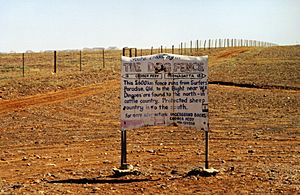
In the 1920s, the Dingo Fence was erected on the basis of the Wild Dog Act (1921) and, until 1931, thousands of miles of Dingo Fences had been erected in several areas of South Australia. In the year 1946, these efforts were directed to a single goal, and the Dingo Fence was finally completed. The fence connected with other fences in New South Wales and Queensland. The main responsibilities in maintaining the Dingo Fence still lies with the landowners, whose properties border on the fence and receive financial support from the government.
Reward system
A reward system (local, as well from the government) was active from 1846 to the end of the 20th century, but there is no evidence that – despite the billions of dollars spent – it was ever an efficient control method. Therefore, its importance declined over time.
Poisoning
Strychnine is still used in all parts of Australia.
Baits with the poison 1080 are regarded as the fastest and safest method for dog control, since they are extremely susceptible. Even small amounts of poison per dog are sufficient (0.3 mg per kg). The application of aerial baiting is regulated in the Commonwealth by the Civil Aviation Regulations (1988). The assumption that the tiger quoll might be damaged by the poison led to the dwindling of areas where aerial baiting could be performed. In areas where aerial baiting is no longer possible, it is necessary to put down baits.
Over the last years, cyanide-ejectors and protection collars (filled with 1080 on certain spots) have been tested.
The eradication of dingoes due to livestock damage decreased along with the importance of the sheep industry and the usage of strychnine (which beforehand had been used for 100 years) in the 1970s. The number of doggers also decreased and the frequency of government-approved aerial baiting increased. During this period, many farmers in Western Australia switched to the cattle industry, and findings in the area of biology led to a significant change in control measures and techniques in association with reduced costs and increased efficiency. At the same time, the importance of 1080 increased.
Neutering
Owners of dingoes and other domestic dogs are sometimes asked to neuter their pets and keep them under observation to reduce the number of stray/feral dogs and prevent interbreeding with dingoes.
Efficiency of measures
The efficiency of control measures was questioned in the past and is often questioned today, as well as whether they stand in a good cost-benefit ratio. The premium system proved to be susceptible to deception and to be useless on a large scale, and can therefore only be used for getting rid of "problem-dogs". Animal traps are considered inhumane and inefficient on a large scale, due to the limited efficacy of baits. Based on studies, it is assumed that only young dogs that would have died anyway can be captured. Furthermore, wild dogs are capable of learning and sometimes are able to detect and avoid traps quite efficiently. In one case, a dingo bitch followed a dogger and triggered his traps one after another by carefully pushing her paw through the sand that covered the trap.
Poisonous baits can be very effective when they are of good meat quality; however, they do not last long and are occasionally taken by red foxes, quolls, ants and birds. Aerial baiting can nearly eliminate whole dingo populations. Livestock guardian dogs can effectively minimise livestock losses, but are less effective on wide open areas with widely distributed livestock. Furthermore, they can be a danger to the livestock or be killed by control measures themselves when they are not sufficiently supervised by their owners. Fences are reliable in keeping wild dogs from entering certain areas, but they are expensive to build, need permanent maintenance, and only cause the problem to be relocated.
Control measures mostly result in smaller packs and a disruption of pack structure. The measures seem to be rather detrimental to the livestock industry because the empty territories are taken over by young dogs and the predation then increases. Nonetheless, it is regarded as unlikely that the control measures could completely eradicate the dingo in Central Australia, and the elimination of all wild dogs is not considered a realistic option.
It has been shown that culling a small percentage of immature dingoes on Fraser Island have little significant negative impact on the overall island population, though this is being disputed.
Conservation
Until 2004, the dingo was categorised as of "least concern" on the Red List of Threatened Species. However, it has since been recategorised as "vulnerable," following the decline in numbers to around 30% of "pure" dingoes, due to crossbreeding with domestic dogs.
Dingoes are reasonably abundant in large parts of Australia, but there is some argument that they are endangered due to interbreeding with other dogs in many parts of their range. Dingoes are not a protected species, but they are regulated under federal law and, thus, their status varies in different states and territories. Dingoes receive varying levels of protection in conservation areas such as national parks and natural reserves in New South Wales, the Northern Territory and Victoria, Arnhem Land and other Aboriginal lands, UNESCO World Heritage Sites, and the whole of the Australian Capital Territory. In some states, dingoes are regarded as declared pests and landowners are allowed to control the local populations. Throughout Australia, all other wild dogs are considered pests.
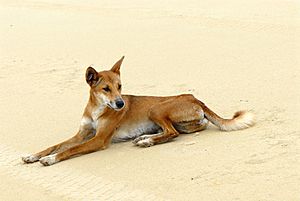
The dingoes of Fraser Island are considered to be of significant conservational value. Due to their geographic and genetic isolation, they are considered to be the most similar to the original dingoes, and they are seen as the most pure dingo population. The dingoes there are not "threatened" by interbreeding with other domestic dogs. Because of their conservational value, outrage was sparked in January 2013 when two six-month-old dingo pups were found dead, believed to have been run over near Lake McKenzie. The couple who found the dingoes were outraged at the reaction of the rangers, and Fraser Coast area manager Ross Belcher said that there will be serious penalties for those who kill or injure Fraser Island dingoes.
In February 2013, a report on Fraser Island dingo management strategies was released, with options including ending the intimidation of dingoes, tagging practice changes and regular veterinarian checkups, as well as a permanent dingo sanctuary on the island.
Groups that have devoted themselves to the conservation of the "pure" dingo by using breeding programs include the Australian Native Dog Conservation Society and the Australian Dingo Conservation Association. Presently, the efforts of the dingo conservation groups are considered to be ineffective because most of their dogs are untested or are known to be hybrids.
Dingo conservation efforts focus primarily on preventing interbreeding between dingoes and other domestic dogs in order to conserve the population of pure dingoes. This is extremely difficult and costly. Conservation efforts are hampered by the fact that it is not known how many pure dingoes still exist in Australia. Steps to conserve the pure dingo can only be effective when the identification of dingoes and other domestic dogs is absolutely reliable, especially in the case of living specimens. Additionally, conservation efforts are in conflict with control measures.
Conservation of pure and survivable dingo populations is promising in remote areas, where contact with humans and other domestic dogs is rare. Under New South Wales state policy in parks, reserves and other areas not used by agriculture, these populations are only to be controlled when they pose a threat to the survival of other native species. The introduction of "dog-free" buffer zones around areas with pure dingoes is regarded as a realistic method to stop interbreeding. This is enforced in the way that all wild dogs can be killed outside of the conservation areas. However, studies from the year 2007 indicate that even an intensive control of core areas is probably not able to stop the process of interbreeding.
There is presently no information regarding what opinions the public has regarding the conservation of dingoes. There is no unity on the definition of "pure" dingoes and to what extent they should be controlled.
As a pet
In 1976, the Australian Native Dog Training Society of NSW Ltd. was founded but has now ceased. In 1994, the Australian National Kennel Council recognised a dingo breed standard within its Hounds group.. The dingo is not recognised as a dog breed by the Fédération Cynologique Internationale.
In 2017, a study explored whether dingoes and primitive dog breeds might exhibit less desirable traits than the more recently derived breeds through a survey of their owners. The study found that both modern and ancient breeds were easier to train than the dingo, showed less staring behavior, and were less likely to roll in animal dung than the dingo. The "staring at nothing" behavior was thought to be a reaction to high frequency sounds that humans and some domestic dogs cannot hear. Modern breeds showed less fear of strangers and were less likely to escape. Dingo behavior was outside the range of typical dog behaviors, which indicates that dingoes behave like true wild canids and are behaviorally distinct from modern domesticated dogs. The study concluded that these behaviors might be undesirable to the humans living with dingoes and therefore these behaviors reflect natural selection pressures rather than human selection. Some writers disagree that the dingo should be considered as a dog breed because they believe "true" dingoes can be tamed but not truly domesticated.
Dingoes can be very tame when they come in frequent contact with humans. Furthermore, some dingoes live with humans (due to practical, as well as emotional reasons). Many indigenous Australians and early European settlers lived alongside dingoes. Indigenous Australians would take dingo pups from the den and tame them until sexual maturity and the dogs would leave. Alfred Brehm reported cases where dingoes that were completely tame and, in some cases, behaved exactly like other domestic dogs (one was used for shepherding heavy livestock), as well as specimens that remained wild and shy. He also reported about dingoes that were aggressive and completely uncontrollable, but he was of the opinion that these reports "should not get more attention than they deserve," since the behaviour depends on how the dingo was raised since early puppyhood. He believed that these dogs could become very decent pets.
According to the Austrian behavioral researcher and author Eberhard Trumler, dingoes are very smart and affectionate. To would-be owners, he recommended the provision of a large escape-proof enclosure and a partner of the opposite sex. During heat, dingoes are harder to manage than other domestic dogs which, combined with their attachment to their owners, can lead to problems, since they want to follow their owners and never miss the opportunity to feed. Dingoes are supposed to find every weak spot of an enclosure or residence, escape for a while and stray through towns and villages. Their intellectual ability is supposedly connected to an enormous ability to learn and a lightning perception. Dingoes have a reputation for not handling pressure, but this conflicts with their record as working dogs. They are suitable as shepherd dogs, appearing to see a purpose in it (keeping together a familiar group is in their nature) and, even today, some dingoes are employed as shepherd dogs. In addition, dingoes have strong toileting instincts and can easily be housebroken.
Images for kids
-
Dingo on the beach at Fraser Island, Queensland
-
Portrait of a Large Dog from New Holland by George Stubbs, 1772. National Maritime Museum, Greenwich.
-
"Dog of New South Wales" illustrated in The Voyage of Governor Phillip to Botany Bay in 1788
-
The Sahul Shelf and the Sunda Shelf during the past 12,000 years: Tasmania separated from the mainland 12,000 YBP, and New Guinea separated from the mainland 6,500–8,500 YBP.
See also
 In Spanish: Dingo para niños
In Spanish: Dingo para niños



